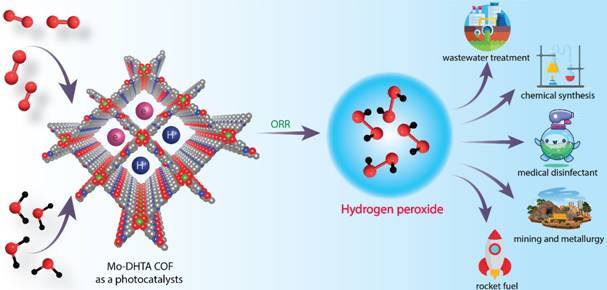Indian Scientists Develop Sunlight-Powered Catalyst to Produce Hydrogen Peroxide
The COF acts as a precisely engineered molecular solar reactor — converting solar energy into chemical energy with high efficiency.

- Country:
- India
In a major scientific advancement, researchers from India have developed a new sunlight-driven, eco-friendly technique to synthesize hydrogen peroxide (H₂O₂) — a widely used disinfectant and industrial oxidizer — directly from water and sunlight. This innovative method employs a metal-embedded covalent organic framework (COF) and may revolutionize the green chemical manufacturing landscape, reducing reliance on conventional, polluting production methods.
The research, carried out by scientists at the S. N. Bose National Centre for Basic Sciences (SNBCBS), an autonomous institute under the Department of Science and Technology (DST), represents a significant leap in the field of photocatalytic green chemistry.
Why Hydrogen Peroxide Matters
Hydrogen peroxide is a versatile and essential oxidizing agent used extensively in:
-
Disinfecting wounds and sterilization
-
Water purification and wastewater treatment
-
Chemical synthesis
-
Fuel cells and industrial oxidations
Importantly, it is environmentally friendly — breaking down into just water and oxygen after use. However, traditional methods of manufacturing hydrogen peroxide rely on the anthraquinone process, which is energy-intensive, hazardous, and emits pollutants.
The Photocatalysis Revolution: Turning Light Into Chemistry
Photocatalysis — the use of light to drive chemical reactions — has emerged as a cleaner alternative. But common photocatalysts like metal oxides, graphitic carbon nitride (g-C₃N₄), polymers, and metal-organic frameworks (MOFs) face serious limitations:
-
Wide band gaps that restrict light absorption
-
Low electron mobility
-
Poor durability in reaction environments
Covalent Organic Frameworks (COFs) offer a potential solution due to:
-
High surface area
-
Tunable porosity
-
Narrow band gaps
-
Excellent photostability
Still, their practical efficiency is hampered by insufficient active catalytic sites and inefficient charge transport.
The Breakthrough: Mo-DHTA COF — A Mini Solar-Powered Factory
To overcome these limitations, the research team, led by Dr. Pradip Pachfule and colleagues including Bidhan Kumbhakar, Avanti Chakraborty, Uttam Pal, and others, engineered a metal-embedded COF named Mo-DHTA COF (short for dimolybdenum paddlewheel–embedded covalent organic framework).
Key Innovations:
-
Dimolybdenum paddlewheel units serve as active centers.
-
α-Hydroquinone linkers provide aromatic stability and help mediate electron transfer.
-
The structure forms a robust, crystalline scaffold that efficiently captures visible light and binds oxygen molecules, which are then reduced to form hydrogen peroxide.
Upon exposure to sunlight:
-
Excitons (electron-hole pairs) are generated in the COF.
-
Electrons reduce oxygen (O₂) to form superoxide radicals (O₂⁻).
-
These radicals react with protons and additional electrons, forming H₂O₂.
The COF acts as a precisely engineered molecular solar reactor — converting solar energy into chemical energy with high efficiency.
Versatility and Recyclability
The Mo-DHTA COF was tested in various liquid environments including ethanol, benzyl alcohol, and even pure water, achieving high hydrogen peroxide yields across the board. Moreover, the material demonstrated:
-
High structural stability
-
Excellent recyclability
-
Consistent photocatalytic performance over multiple cycles
These features make it a durable, scalable candidate for industrial use.
Far-Reaching Applications and Impact
The breakthrough holds promise for a broad spectrum of sectors:
1. Pharmaceuticals and Healthcare
-
Enables on-site, cost-effective H₂O₂ production for sterilization and medical use.
2. Environmental Remediation
-
Can be used in green wastewater treatment, pollution mitigation, and air purification systems.
3. Energy and Materials Science
-
Potential applications in fuel cells, solar-driven water splitting, CO₂ conversion, and value-added chemical production.
A Leap Toward Industrial Transformation
The research was published in the prestigious journal ‘Small’, indicating global recognition of the scientific and technological merit of the study. Future directions may include:
-
Fine-tuning the molecular structure of M-COFs
-
Exploring other transition metals (e.g., Fe, Co, Ni) for embedding
-
Scaling up the technology for commercial chemical plants
With hydrogen peroxide being just one target molecule, this framework could potentially be adapted for the synthesis of a range of green chemicals, heralding a new era in solar-driven sustainable chemistry.
By combining advanced materials science with renewable energy, the Mo-DHTA COF technology offers a sustainable, low-cost, and scalable solution to chemical production. It not only addresses the environmental drawbacks of traditional methods but also opens up a new frontier in photocatalytic manufacturing, where sunlight, water, and smart materials drive the future of green industry.










